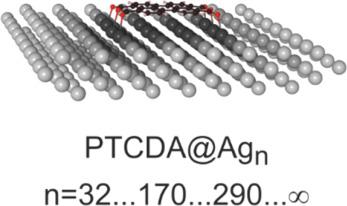当前位置:
X-MOL 学术
›
J. Comput. Chem.
›
论文详情
Our official English website, www.x-mol.net, welcomes your feedback! (Note: you will need to create a separate account there.)
Comparison of the periodic slab approach with the finite cluster description of metal-organic interfaces at the example of PTCDA on Ag(110)
Journal of Computational Chemistry ( IF 3 ) Pub Date : 2018-02-05 , DOI: 10.1002/jcc.25159 Jaita Banerjee 1 , Stefan Behnle 1 , Martin C. E. Galbraith 2 , Volker Settels 3 , Bernd Engels 3 , Ralf Tonner 2 , Reinhold F. Fink 1
Journal of Computational Chemistry ( IF 3 ) Pub Date : 2018-02-05 , DOI: 10.1002/jcc.25159 Jaita Banerjee 1 , Stefan Behnle 1 , Martin C. E. Galbraith 2 , Volker Settels 3 , Bernd Engels 3 , Ralf Tonner 2 , Reinhold F. Fink 1
Affiliation

|
We present a comparative study of metal–organic interface properties obtained from dispersion corrected density functional theory calculations based on two different approaches: the periodic slab‐supercell technique and cluster models with 32–290 Ag atoms. Fermi smearing and fixing of cluster borders are required to make the cluster calculation feasible and realistic. The considered adsorption structure and energy of a PTCDA molecule on the Ag(110) surface is not well reproduced with clusters containing only two metallic layers. However, all clusters with four layers of silver atoms and sufficient lateral extension reproduce the adsorbate structure within 0.04 Å with respect to the slab‐supercell structure and provide adsorption energies of ( −4.45± 0.08 eV) consistent with the slab result of −4.47 eV. Thus, metal–organic adsorbate systems can be realistically represented by properly defined cluster models. © 2018 Wiley Periodicals, Inc.
中文翻译:

在 Ag(110) 上的 PTCDA 示例中,周期板方法与金属-有机界面的有限簇描述的比较
我们基于两种不同的方法,对从色散校正密度泛函理论计算中获得的金属-有机界面特性进行了比较研究:周期性平板超级电池技术和具有 32-290 个 Ag 原子的簇模型。需要费米涂抹和固定簇边界才能使簇计算可行和现实。所考虑的 PTCDA 分子在 Ag(110) 表面上的吸附结构和能量不能用仅包含两个金属层的簇很好地再现。然而,所有具有四层银原子和足够横向扩展的簇都在 0.04 Å 范围内再现了相对于板 - 超胞结构的吸附结构,并提供 ( -4.45± 0.08 eV) 的吸附能,与板结果 -4.47 eV . 因此,金属-有机吸附物系统可以通过正确定义的簇模型来实际表示。© 2018 Wiley Periodicals, Inc.
更新日期:2018-02-05
中文翻译:

在 Ag(110) 上的 PTCDA 示例中,周期板方法与金属-有机界面的有限簇描述的比较
我们基于两种不同的方法,对从色散校正密度泛函理论计算中获得的金属-有机界面特性进行了比较研究:周期性平板超级电池技术和具有 32-290 个 Ag 原子的簇模型。需要费米涂抹和固定簇边界才能使簇计算可行和现实。所考虑的 PTCDA 分子在 Ag(110) 表面上的吸附结构和能量不能用仅包含两个金属层的簇很好地再现。然而,所有具有四层银原子和足够横向扩展的簇都在 0.04 Å 范围内再现了相对于板 - 超胞结构的吸附结构,并提供 ( -4.45± 0.08 eV) 的吸附能,与板结果 -4.47 eV . 因此,金属-有机吸附物系统可以通过正确定义的簇模型来实际表示。© 2018 Wiley Periodicals, Inc.


























 京公网安备 11010802027423号
京公网安备 11010802027423号